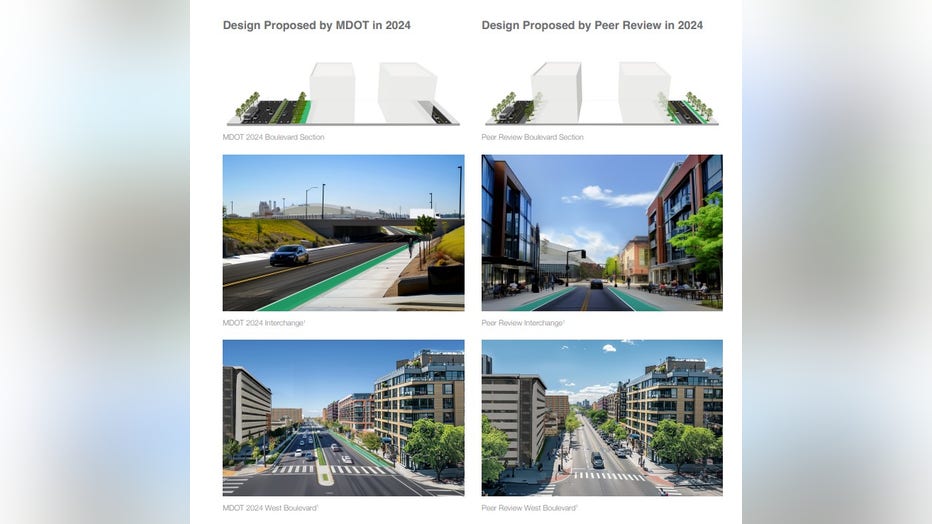Downtown Detroit Partnership makes recommendations for I-375 rebuild

MDOT I-375 corridor redesign forum held at Eastern Market
The Michigan Department of Transportation set up in the Eastern Market shopping around its I-375 reconnecting communities project. The forum provided an open house for ideas - with a sensitivity to the emotional past that is intertwined with the freeway.
DETROIT (FOX 2) - As the state gets closer to finalizing the design for its massive I-375 removal project in Detroit, one of the city's biggest stakeholder groups are making recommendations on how to best approach the task.
With more than $300 million in funding needed and approximately 30 acres of land expected to be altered, the Downtown Detroit Partnership's chief executive officer hopes the people behind the project are keeping the impact in mind.
"Let's make sure we're planning for the next hundred years," said Eric Larson. "This is going to be another 70 to 100 year investment and a lot can change. What are the things we need to think about?"
From explicit objectives like restoring the street grid to more abstract goals like paying homage to the culture and history of the neighborhoods paved over by I-375, the DDP hopes the end result will be a blend of pragmatic solutions and wishes of the community.
That's why the partnership released a peer review this week with its own set of recommendations for the project, which included land use suggestions, honoring the city's legacy, and taking advantage of a momentous chance to reimagine a large swath of valuable land in Detroit.
"This is truly a generational opportunity," Larson said. "You don't rebuild a highway often and you don't often have a highway with so much history and emotion tied to it."
Rebuild I-375: Where it stands
The Michigan Department of Transportation's initial design for replacing the highway included a nine-lane boulevard, something that residents took issue with when presented with renderings during community meetings.
The latest rendition includes five or six lanes with a bigger emphasis on walkability and ensuring it is more friendly to pedestrians.
According to Larson, MDOT is about 30% done with the final design. It released its peer review to coincide with the hiring of AECOM to lead the design and engineering of the project. They'll be in charge of finalizing the design and scheduling the construction.
Detroit has also hired a firm called Interboro for their own consultation.
While the schedule for a final design is fluid, MDOT could break ground on the project in late 2025 or early 2026.
MDOT also has another public meeting scheduled on Dec. 3 and is encouraging community members and stakeholders to take part.
Downtown Detroit Partnership recommendations
The DDP's peer review came in three sections: opportunity, evaluation, and mitigation.
The first component offered three scenarios for developing the land that prioritizes either housing, cultural heritage, or sports and recreation. Larson envisions whatever the Michigan Department of Transportation comes up with will be a combination of the trio of ideas.
"Sports, residential, and cultural - all of that already exists. Our point is you need to continue to blend a balance of the needs of all these uses and activities," he said.
Another big element would be trees and protected bike lanes that line the road, as well a affordable housing and public spaces that "reflect some of what was there when Black Bottom and Paradise Valley were at their most robust and vital," Larson said.
The second review sought to better understand the scope of MDOT's work and a critical review of how their design as changed over time.
Among the changes that should be considered is a redesigned interchange that best connects to Detroit's street grid that best uses available land. The report also said reconnecting downtown to homes and businesses outside of the city center should be embraced.
Finally, it said the proposed boulevard width should be made smaller. Traffic volumes have fallen since the pandemic, and new road construction should reflect the change.

Renderings showing MDOT's plan for the boulevard and the Downtown Detroit Partnership's recommendations. Design via DDP report
The newest design includes as few as four lanes for travel and a 30 mph posted speed.
Finally, MDOT will need to mitigate the impacts of construction the best they can, the third section reads, including traffic maintenance, emergency services, noise, and air quality.
The DDP also expects between 3-8% of nearby businesses may close or relocate during the three-year period and proper strategies can help mitigate more business loss.

